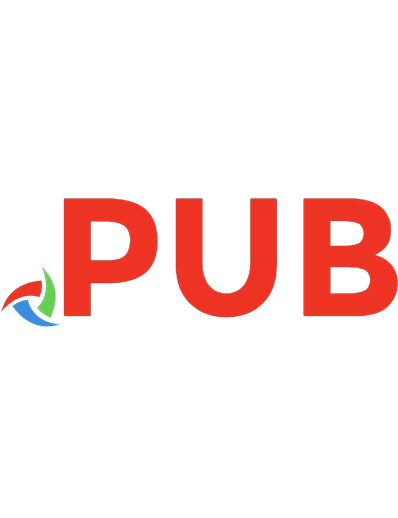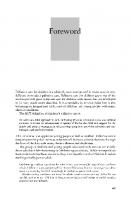Guidelines for Nursing Excellence in the Care of Children, Youth, and Families [2 ed.] 0826169619, 9780826169617
This distinguished title, written by nationally recognized nursing experts in health care and pediatrics, delivers the m
390 71 23MB
English Pages 396 [395] Year 2017
Table of contents :
Cover
Title
Copyright
Contents
Contributors
Foreword
Preface
Share Guidelines for Nursing Excellence in the Care of Children, Youth, and Families, Second Edition
Chapter 1: Children and Youth Have an Identified Health Care Home (Medical Home)
Introduction to the Guideline
Definitions of a Health Care Home
Historical Overview
Guideline Importance
Theoretical/Literature Support for the Guideline and Indicators
Outcomes for CYSHCN
Models of Pediatric Health Care Home/Medical Models for CYSHCN
Outcomes for Children With Chronic Conditions
Outcomes Related to Early Childhood Development and Primary Prevention
Outcomes Related to CYSHCN With Autism
Outcomes Related to CYSHCN in Foster Care
Transition of CYSHCN Into Adult Care
Implications of the Guideline for the Following Areas of Nursing Practice
Clinical
Education
Policy
Research
Case Study
Discussion
Summary
References
Chapter 2: Children, Youth, and Families Receive Care That Supports Growth and Development
Introduction to the Guideline
Definition of the Guideline
Historical Overview
Guideline Importance
Theoretical/Literature Support for the Guideline and Indicators
Implications of the Guideline for the Following Areas of Nursing Practice
Clinical
Education
Policy
Research
Case Study
Summary
References
Chapter 3: Children, Youth, Families, and Health Care Providers Are Partners in Decisions, Planning, and Delivery of Care, Including Appropriate Community Services
Introduction to the Guideline
Definition of the Guideline
Historical Overview
Guideline Importance
Theoretical/Literature Support for the Guideline and Indicators
Indicators of Child and Family Partnerships
Implications of the Guideline for the Following Areas of Nursing Pracitce
Clinical
Education
Policy
Research
Case Study
Discussion
Summary
References
Chapter 4: Cultural Values, Beliefs, and Preferences Are Integral to Family-Centered Care
Introduction to the Guideline
Definition of the Guideline
Historical Overview
Guideline Importance
Theoretical/Literature Support for the Guideline and Indicators
Risk Factors for Families, Children, and Adolescents
Protective Factors for Families, Children, and Adolescents
Sociocultural Issues in Family-Centered Care
Implications of the Guideline for the Following Areas of Nursing Practice
Clinical
Education
Policy
Research
Case Study
Discussion
Case Study
Discussion
Summary
References
Chapter 5: Family Concerns Are Recognized as a Priority, and Family Strengths Are Respected and Supported in the Care of Children and Youth
Introduction to the Guideline
Definition of the Guideline
Historical Overview
Guideline Importance
Theoretical/Literature Support for the Guideline and Indicators
Recognizing Family Concerns as a Priority
Family Strengths Are Respected and Supported
Implications of the Guideline for the Following Areas of Nursing Practice
Clinical
Education
Policy
Research
Case Study
Summary
Note
References
Chapter 6: Children, Youth, and Families Have High-Quality, Affordable, and Accessible Health Care
Introduction to the Guideline
Definition of the Guideline
Historical Overview
Guideline Importance
Theoretical/Literature Support for the Guideline and Indicators
Implications of the Guideline for the Following Areas of Nursing Practice
Clinical
Education
Policy
Research
Case Study
Discussion
Summary
References
Chapter 7: The Child’s, Youth’s, and Family’s Needs Are Identified, Prioritized, and Services Are Offered
Introduction to the Guideline
Definition of the Guideline
Historical Overview
Guideline Importance
Theoretical/Literature Support for the Guideline and Indicators
Guideline Recommendations and Evidence
Implications of the Guideline for the Following Areas of Nursing Practice
Clinical
Education
Policy
Research
Case Study
Discussion
Summary
References
Appendix 7.1 Behavioral Change Theories
Ecological Model
Social Cognitive Theory (SCT)
Theory of Reasoned Action
Theory of Planned Behavior
Health Belief Model
Transtheoretical Model
Chapter 8: Children, Youth, and Families Receive Care That Optimizes Wellness, Promotes and Maintains Physical and Mental Health, and Prevents Disease and Injury
Introduction to the Guideline
Definition of the Guideline
Historical Overview
Guideline Importance
Theoretical/Literature Support for the Guideline and Indicators
The Health Belief Model
The Transtheoretical Model
The Socioecological Model
Injury-Prevention Guidelines
Implications of the Guideline for the Following Areas of Nursing Practice
Clinical
Education
Policy
Research
Case Study
Discussion
Summary
References
Chapter 9: Pregnant Adolescents and Women, Children, Youth, and Families Have Access to Genetic and Genomic Testing and Genomic-Appropriate Counseling
Introduction to the Guideline
Definition of the Guideline
Historical Overview
Guideline Importance
Theoretical/Literature Support for the Guideline and Indicators
Implications of the Guidleine for the Following Areas of Nursing Practice
Clinical
Education
Policy
Research
Case Study
Discussion
Summary
References
Chapter 10: Children and Youth Receive Care That Is Delivered in a Physically and Emotionally Safe Environment
Introduction to the Guideline
Definition of the Guideline
Historical Overview
Theoretical/Literature Support for the Guideline and Indicators
Physically Safe Environments
Emotionally Safe Environments
Implications of the Guideline for the Following Areas of Nursing Practice
Clinical
Education
Policy
Research
Case Study
Discussion
Summary
References
Chapter 11: Children’s, Youth’s, and Families’ Privacy and Rights Are Protected
Introduction to the Guideline
Definition of the Guideline
Historical Overview
Theoretical/Literature Support for the Guideline and Indicators
Guideline Importance
Privacy Rule
Implications of the Guideline for the Following Areas of Nursing Practice
Clinical
Education
Policy
Research
Case Study
Summary
References
Chapter 12: Children and Youth With Acute, Critical, or Chronic Needs and Their Families Receive the Full Range of Services
Introduction to the Guideline
Definition of the Guideline
Historical Overview
Guideline Importance
Theoretical/Literature Support for the Guideline and Indictors
Preventive Services
Emergency Care and Hospital- and Facility-Based Care
Therapeutic Services, Durable Medical Equipment, and Ancillary Services
Lab, Diagnostic Assessment, and Testing Services
Gaps in Services for the Low-Income Population
Implications of the Guideline for the Following Areas of Nursing Practice
Clinical
Education
Policy
Research
Case Study
Discussion
Summary
References
Chapter 13: Children and Youth With Disabilities and/or Special Health Care Needs and Their Families Receive the Full Range of Services
Introduction to the Guideline
Definition of the Guideline
Historical Overview
Guideline Importance
Theoretical/Literature Support for the Guideline and Indicators
Self-Management
Care Coordination and Service Referrals
Advocacy
Implications of the Guideline for the Following Areas of Nursing Practice
Clinical
Education
Policy
Research
Case Study
Discussion
Summary
References
Chapter 14: Children, Youth, and Families Receive Appropriate Palliative and/or Hospice Care
Introduction to the Guideline
Definition of the Guideline
Historical Overview
Guideline Importance
Generalist and Specialist Palliative Care
Theoretical/Literature Support for the Guideline and Indicators
Dimensions of Palliative Care and Hospice Care
Implications of the Guideline for the Following Areas of Nursing Practice
Clinical
Education
Policy
Research
Case Study
Summary
Note
References
Chapter 15: Children, Youth, and Families Receive Appropriate Prevention and Community Referral Services
Introduction to the Guideline
Definition of the Guideline
Historical Overview
Guideline Importance
Theoretical/Literature Support for the Guideline and Indicators
Implications of the Guideline for the Following Areas of Nursing Practice
Clinical
Education
Policy
Research
Case Study
Discussion
Summary
Recommended Reading
References
Websites of Interest
Chapter 16: Children’s, Youth’s, and Families’ Health Risk Behaviors and Problems Are Identified and Addressed
Introduction to the Guideline
Definition of the Guideline
Historical Importance
Guideline Importance
Theoretical/Literture Support for the Guideline and Indicators
Theoretical Frameworks
Synthesis of the Literature
Implications of the Guideline for the Following Areas of Nursing Practice
Clinical
Education
Policy
Research
Case Study
Discussion
Summary
References
Chapter 17: Children, Youth, and Families Are Fully Informed of the Process, Outcomes, and Alternatives to Care, Including Quality of Life
Introduction to the Guideline
Definition of the Guideline
Historical Overview
Guideline Importance
Theoretical/Literature Support for the Guideline and Indicators
Health Literacy
Children’s Level of Competence
Complementary and Alternative Medicine
Implications of the Guideline for the Following Areas of Nursing Practice
Clinical
Education
Policy
Research
Summary
References
Index
![Guidelines for Nursing Excellence in the Care of Children, Youth, and Families [2 ed.]
0826169619, 9780826169617](https://dokumen.pub/img/200x200/guidelines-for-nursing-excellence-in-the-care-of-children-youth-and-families-2nbsped-0826169619-9780826169617.jpg)


![Nursing interventions for infants, children, and families [2. ed.]
9780761907251, 0761907254](https://dokumen.pub/img/200x200/nursing-interventions-for-infants-children-and-families-2-ed-9780761907251-0761907254.jpg)
![Nursing Care Plans: Guidelines for Individualizing Client Care Across the Life Span [10 ed.]
0803660863, 9780803660861](https://dokumen.pub/img/200x200/nursing-care-plans-guidelines-for-individualizing-client-care-across-the-life-span-10nbsped-0803660863-9780803660861.jpg)




![Training the Future Child Health Care Workforce to Improve the Behavioral Health of Children, Youth, and Families: Proceedings of a Workshop [1 ed.]
9780309464628, 9780309464611](https://dokumen.pub/img/200x200/training-the-future-child-health-care-workforce-to-improve-the-behavioral-health-of-children-youth-and-families-proceedings-of-a-workshop-1nbsped-9780309464628-9780309464611.jpg)
![Advancing the Power of Economic Evidence to Inform Investments in Children, Youth, and Families [1 ed.]
9780309440608, 9780309440592](https://dokumen.pub/img/200x200/advancing-the-power-of-economic-evidence-to-inform-investments-in-children-youth-and-families-1nbsped-9780309440608-9780309440592.jpg)